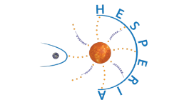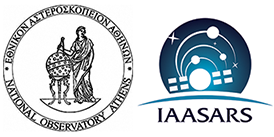The HESPERIA REleASE+ notification system
HESPERIA REleASE+ makes use of both:
Ø relativistic electrons (v > 0.9 c) provided by the Electron Proton Helium Instrument (EPHIN) on SOHO and near-relativistic (v <0.8 c) electron measurements from the Electron Proton Alpha Monitor (EPAM) aboard the Advanced Composition Explorer (ACE), and
Ø a novel radio module that qualifies type-III radio bursts from STEREO-A SWAVES real-time radio spectrograms which have the potential of causing near-Earth significant solar proton events and sets a forecasting window (FW), namely the maximum time interval within which a significant proton event is expected to occur after the onset of the qualified strong type-III radio burst
A gauge with a needle indicates in real-time and in a user-friendly mode the expected radiation impact labelled according to the following three discrete levels:
─ Quiet l Green
color
─ Warning l Orange
color
─ Alert l Red Color
At the top of the gauge, we indicate if the HESPERIA REleASE+ forecasting system is presently running, or if we have alternatively switched to HESPERIA REleASE due to the presence of significant gaps in STEREO/A SWAVES data. Below the gauge we indicate if a significant solar proton event (SEP) is presently on-going or not. The duration of an on-going SEP event is defined as the time interval between the proton event occurrence (when the proton flux first surpasses the 0.1 cm-2 s-1 sr-1 MeV-1 threshold at either energy channel) and the time that the one-hour averaged proton flux drops in both energy channels below 0.025 cm-2 s-1 sr-1 MeV-1.
The HESPERIA REleASE+ Alert System can generate alerts which are distributed to registered users. You can register here.
Validation for forecast flux conditions
Historic (not real-time) data of SOHO/EPHIN and ACE/EPAM from 2009 to 2016 were used to find a good forecast flux condition for SEP event and to quantify the event-oriented validation metrics (POD, FAR and warning time). We tested different combination of forecasts for different time offsets and found that the following condition delivered the best performance of the forecast systems:
Ø Alarm: if any forecast >10-1 (cm2 sec sr MeV)-1 and one 30-minute forecast >10-2 (cm2 sec sr MeV)-1.
Ø Event: if real proton flux >10-1 (cm2 sec sr MeV)-1.
|
|
True |
Missed |
False |
POD % |
FAR % |
Average warning time / min |
|
EPHIN |
24 |
14 |
10 |
63 |
29 |
107 |
|
EPAM |
24 |
14 |
13 |
63 |
35 |
123 |
Malandraki, O., Heber, B., et al., 2020. Solar Particle Radiation Storms Forecasting and Analysis – The HESPERIA tools, European Geosciences Union General Assembly Conference Abstracts, p. 8298
Malandraki, O., and Crosby, N. B., Eds., Solar Particle Radiation Storms Forecasting and Analysis, vol. 444. Cham: Springer International Publishing, 2018, doi: 10.1007/978-3-319-60051-2.
Performance assessment of HESPERIA REleASE+
Historic (not real-time) data of SOHO/EPHIN from September 2021 to December 2023 were used to assess the performance of the HESPERIA REleASE+ system. Please note that the assessment duration is very limited, including the occurrence of actual events, therefore, the statistical uncertainty is large. Statistics are expected to improve with a longer period of monitoring of the HESPERIA REleASE+ system.
|
|
True |
Missed |
False |
POD % |
FAR % |
Average warning time / min |
|
EPHIN |
16 |
3 |
17 |
84 |
52 |
70 |
Posner A., Malandaki O., et al., 2024. HESPERIA REleASE+: Improving Solar Proton Event Forecasting by means of Automated Recognition of Type-III Radio Bursts, Space Weather Journal, Submitted.

 hesperia [dot] info [at] hesperia-space [dot] eu
hesperia [dot] info [at] hesperia-space [dot] eu


